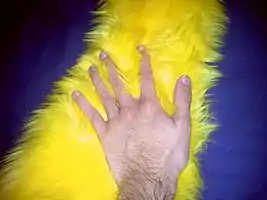Stimming
Self-stimulatory behavior, also known as stimming[1] and self-stimulation,[2] is the repetition of physical movements, sounds, words, moving objects, or other repetitive behaviors. Such behaviors (also scientifically known as 'stereotypies') are found to some degree in all people, especially those with developmental disabilities, and are especially frequent in people on the autism spectrum.[2] People diagnosed with sensory processing disorder are also known to potentially exhibit stimming behaviors.[3] Stimming has been interpreted as a protective response to overstimulation, in which people calm themselves by blocking less predictable environmental stimuli, to which they have a heightened sensitivity.[2][3] A further explanation views stimming as a way to relieve anxiety and other negative or heightened emotions.[4] Although some stimming behaviors are very beneficial at times,[5][6] stimming has been highly stigmatized and dramatized. People who are neurodivergent often feel that they need to hide or decrease their self-stimulatory behavior, as it often elicits an undesirable response from those who do not understand the compulsion behind them. There are also potential mental health and well-being risks in suppressing stimming.[7][6][5][8]

Stimming behaviors can consist of tactile, visual, auditory, olfactory, and vestibular stimming (which pertains to balance). Some common examples of stimming (sometimes called stims[9]) include hand flapping, clapping, rocking, excessive or hard blinking, pacing, head banging, repeating noises or words, snapping fingers, and spinning objects.[10][11] In some cases, stimming may be dangerous and physically harmful to the person doing it; for example, individuals may risk injuring themselves by forcefully banging their body parts against walls.[12]
Stimming and autism
Stimming is almost always present in people on the autism spectrum but does not necessarily indicate its presence.[13] The biggest difference between autistic and non-autistic stimming is the type of stim and the quantity of stimming.[13] In the Diagnostic and Statistical Manual of Mental Disorders, published by the American Psychiatric Association, stimming behavior is described as "stereotyped or repetitive motor mannerisms" and listed as one of the five key diagnostic criteria of autism spectrum disorder.[14] Different perspectives suggest that stimming involves both sensory and motor functions. Underdevelopment of these sensorimotor functions can result in stimming behaviors produced by the person as a controllable response. One study which interviewed thirty-two autistic adults found that unpredictable and overwhelming environments caused stimming.[15]

Stimming can sometimes be self-injurious, such as when it involves head-banging, hand-biting, excessive self-rubbing, and scratching the skin.[16] While it is difficult to stop stimming entirely, there are ways to reduce time spent stimming and create safer stimming habits for an individual. Managing the sensory and emotional environment while increasing the amount of daily exercise can increase comfort levels for the person, which may reduce the amount of time spent stimming.[17]
See also
- ASMR
- Snoezelen
- Fidget spinner
- Hug machine
References
- Rosalind Bergemann (2013). An Asperger Leader's Guide to Living and Leading Change. Jessica Kingsley Publishers. ISBN 9780857008725.
- Valerie Foley (2011). The Autism Experience. ReadHowYouWant.com. ISBN 9781458797285.
- Gretchen Mertz Cowell (2004). Help for the Child with Asperger's Syndrome: A Parent's Guide to Negotiating the Social Service Maze. Jessica Kingsley Publishers. ISBN 9781846420429.
- Eileen Bailey (15 July 2011). "Autism Spectrum Disorders and Anxiety". Health Central. Retrieved 25 March 2014.
- Charlton, Rebecca A.; Entecott, Timothy; Belova, Evelina; Nwaordu, Gabrielle (2021). ""It feels like holding back something you need to say": Autistic and Non-Autistic Adults accounts of sensory experiences and stimming". Research in Autism Spectrum Disorders. 89: 101864. doi:10.1016/j.rasd.2021.101864. S2CID 240532683.
- Collis, E.; Gavin, J.; Russell, A.; Brosnan, M. (February 2022). "Autistic adults' experience of restricted repetitive behaviours". Research in Autism Spectrum Disorders. 90: 101895. doi:10.1016/j.rasd.2021.101895. S2CID 244869197.
- Kapp, Steven K; Steward, Robyn; Crane, Laura; Elliott, Daisy; Elphick, Chris; Pellicano, Elizabeth; Russell, Ginny (28 February 2019). "'People should be allowed to do what they like': Autistic adults' views and experiences of stimming". Autism. 23 (7): 1782–1792. doi:10.1177/1362361319829628. ISSN 1362-3613. PMC 6728747. PMID 30818970.
- McCormack, Lynne; Wong, Sze Wing; Campbell, Linda E. (4 July 2022). "'If I don't Do It, I'm Out of Rhythm and I Can't Focus As Well': Positive and Negative Adult Interpretations of Therapies Aimed at 'Fixing' Their Restricted and Repetitive Behaviours in Childhood" (PDF). Journal of Autism and Developmental Disorders. Springer Science and Business Media LLC. doi:10.1007/s10803-022-05644-6. ISSN 0162-3257.
- Temple Grandin, PhD (November 2011). "Why Do Kids with Autism Stim?". Autism Digest. Archived from the original on 31 March 2014. Retrieved 25 March 2014.
- Eileen Bailey (27 August 2012). "Stimming". Health Central. Retrieved 25 March 2014.
- "Stimming: What autistic people do to feel calmer". BBC. 5 June 2013. Retrieved 25 March 2014.
- Smith, Lori; Legg, Timothy J. (19 February 2018). "What is stimming?". Medical News Today. Retrieved 19 April 2022.
For some, stimming can include higher-risk behaviors such as banging their hands, head, legs, and objects, which may be potentially physically harmful.
- Rudy, Lisa Jo (13 October 2009). "Stimming". About.com. Retrieved 24 March 2014.
- American Psychiatric Association (2013). Diagnostic and statistical manual of mental disorders : DSM-5 (5 ed.). Arlington, VA. ISBN 978-0-89042-554-1. OCLC 830807378.
- Kapp, Steven K. (2019). "'People should be allowed to do what they like': Autistic adults' views and experiences of stimming". Autism. 23 (7): 1782–1792. doi:10.1177/1362361319829628. PMC 6728747. PMID 30818970.
- Fadhil, Tamara (2018). "Live Monitoring System for Recognizing Varied Emotions of Autistic Children". 2018 International Conference on Advanced Science and Engineering (ICOASE). pp. 151–155. doi:10.1109/ICOASE.2018.8548931. ISBN 978-1-5386-6696-8. S2CID 54224210.
- Cunningham, Allison (2008). "Stereotypy in Autism: The Importance of Function". Research in Autism Spectrum Disorders. 2 (3): 469–479. doi:10.1016/j.rasd.2007.09.006. PMC 2598746. PMID 19122856.